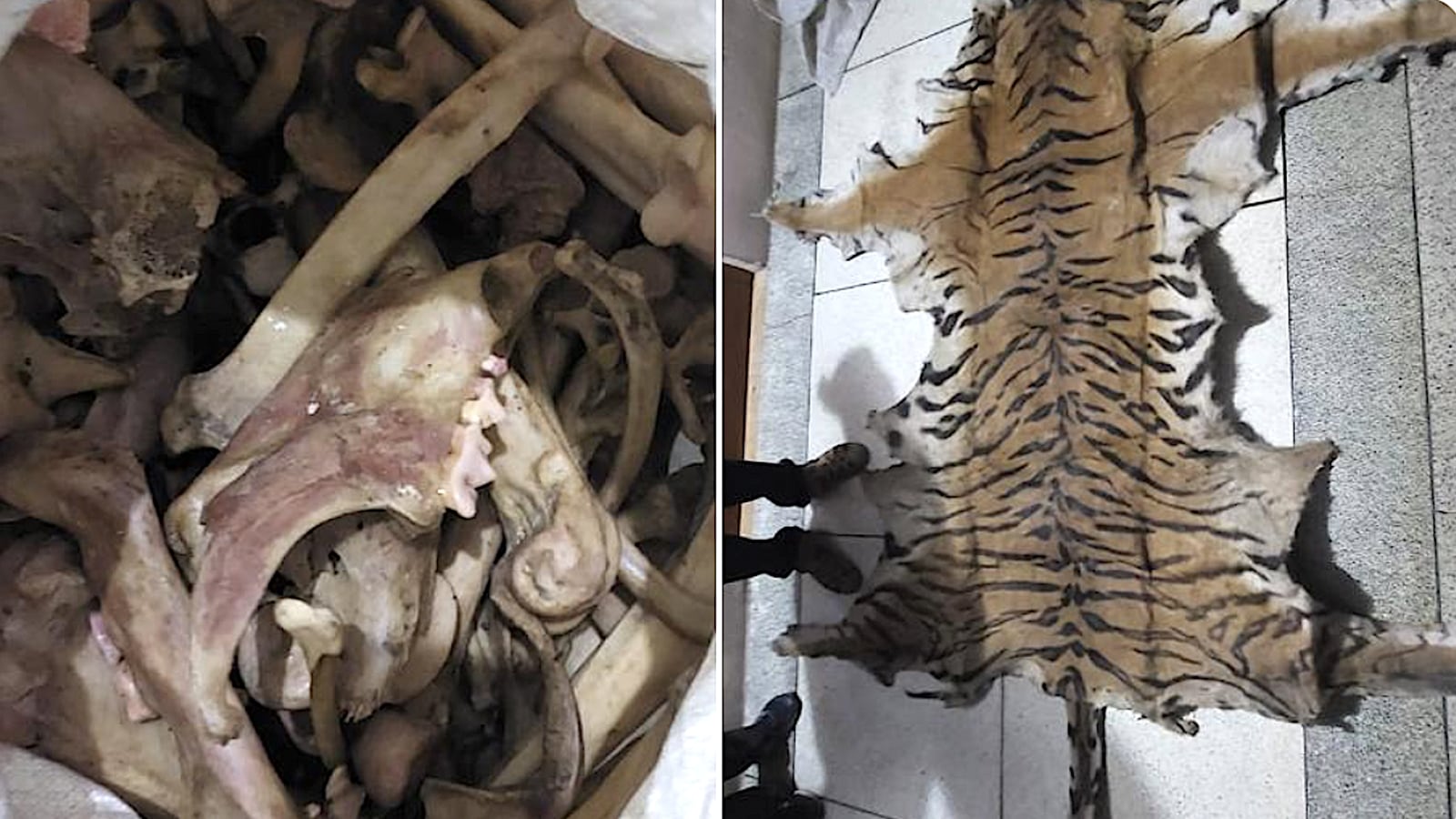For decades, the tiger mafia in India preferred the shortest routes to China’s demanding markets: through Nepal and Tibet. The longer northeastern route to Myanmar, meanwhile, was the mainstay of rhino horn traders who took consignments out of Assam.
Since the 1990s, periodic seizures of pangolin scales in Meghalaya and Mizoram did point to the northeast route for wildlife contraband sourced from central India although tiger traders started significantly realigning their supply lines only just before the Covid pandemic. But even as the Myanmar route got busy with consignments of tiger bone and skins by 2022, the agencies tasked with busting them continued to operate in trenches.

So much so, a string of arrests and seizures across India since mid-2023 failed to blow the lid off these new-age poaching syndicates — until this January. By then, as an investigating officer said, “the damage was done.”
It is not difficult to see why.
 A tiger caught on camera (above) in Maharashtra’s Chandrapur forests showed up as a skin-and-bone consignment (top) in Assam within six months in 2023. (Image: Special Arrangement)
A tiger caught on camera (above) in Maharashtra’s Chandrapur forests showed up as a skin-and-bone consignment (top) in Assam within six months in 2023. (Image: Special Arrangement)
After Rajasthan’s Sariska reserve lost all its tigers to poaching by 2005, the Government initiated a series of reforms by establishing the National Tiger Conservation Authority (NTCA) and the Wildlife Crime Control Bureau (WCCB) in 2007. Earlier, the CBI handled major tiger poaching cases, and even with WCCB in place, it pursued occasional cases along with DRI to meet their mandate of combating wildlife crime.
The problem, according to key officials tracking wildlife crime, was that all of these agencies worked, and still do, in silos with hardly any coordination.
Even state forest departments rarely keep track of cases in other states, despite poaching syndicates operating across multiple states. Except on rare occasions, like two poaching cases registered in Assam and Maharashtra that were successfully linked recently by the two state forest departments.
 India’s tiger trade trail.
India’s tiger trade trail.
The WCCB, the government’s specialised arm for fighting wildlife crime, has a sanctioned strength of just 10 wildlife inspectors — those actually trained in wildlife and can gather vital field intelligence. Four of those posts are currently vacant. Overall, the bureau has 24% vacancy – ie, 26 posts of its sanctioned strength of just 109.
Story continues below this ad
“Unlike wildlife inspectors, WCCB inspectors come from paramilitary forces on deputation for just three years and lack domain expertise. As permanent recruits, wildlife inspectors are also important for institutional knowledge. But it is difficult even to fill up the few posts of wildlife inspectors without room for promotion or growth,” said a senior WCCB officer. For instance, the only step up for a wildlife inspector is to the assistant director level, with just three posts across the country for those promoted internally.
“The enforcement community is hamstrung because governments fail to treat wildlife crime seriously enough. There is little political will, leading to insufficient resources and curtailed mandate. When there is barely any domestic coordination, how do you expect Nepal, China or Myanmar to cooperate?” asked a former CBI officer who has investigated wildlife crime.
A handful of NGOs dedicated to combating wildlife crime have also been caught napping. “There was some complacency with good tiger numbers. Perhaps, some good field-hands now spend more time in the office. Perhaps, conservation giants who used to support anti-trafficking work have not been responsive lately. So there was a vacuum that allowed a perfect storm of sorts to surprise everybody,” said Jose Louies, chief of enforcement at Wildlife Trust of India.
 Tiger skin and bone seized from Uttarakhand’s Khatima in July 2023 from a gang operating in and around Corbett tiger reserve. (Photo: WCCB)
Tiger skin and bone seized from Uttarakhand’s Khatima in July 2023 from a gang operating in and around Corbett tiger reserve. (Photo: WCCB)
That storm unfolded while nobody was looking — or looking north.
Story continues below this ad
According to officials, Delhi, Lucknow and Kanpur have been the traditional hubs used mostly by Nepalese and Tibetan nationals tying up with Indian poachers. Their favourite routes were through the Mahakali-Darchula border between Uttarakhand’s Pithoragarh and Nepal’s Sudurpashchim, and the Sunauli-Belahiya border in UP’s Maharajganj. Another route to Nepal ran from West Bengal’s Siliguri.
From Nepal, the tiger traders took multiple routes, such as through Taklakot, Gyirong and Tatopani, to Tibet. The wildlife mafia also used a direct link to Tibet through Shimla and Ladakh — via Shiquanhe, a town in western Tibet, around 60 km from Ladakh’s Demchok.
Although there were reports of tiger parts smuggled through China’s Yunnan in the southeast, including occasional consignments sourced from India, it was in the post-pandemic years that the Myanmar route to China — directly or via Vietnam and possibly Laos — became a prime exit channel.
As multiple investigations try to unravel these syndicates, bringing cases to their logical conclusion also presents a big challenge. Between the first major tiger poaching wave during 1992-1994 and the second in 2003-05, Delhi-based NGO Wildlife Protection Society of India (WPSI) tracked over 1400 individuals linked to tiger or leopard trade and found only 14 records of convictions and sentencing. Not much has changed since.
Story continues below this ad
“Conviction rates have improved in some states but the prosecution continues to be lethargic in others. Even when convicted, most of them return to the trade when released. Their families have been in this business, often for generations. We need strong political will to back enforcement to break this cycle and maintain constant vigil,” said Tito Joseph, program manager, WPSI.



 A tiger caught on camera (above) in Maharashtra’s Chandrapur forests showed up as a skin-and-bone consignment (top) in Assam within six months in 2023. (Image: Special Arrangement)
A tiger caught on camera (above) in Maharashtra’s Chandrapur forests showed up as a skin-and-bone consignment (top) in Assam within six months in 2023. (Image: Special Arrangement) Tiger skin and bone seized from Uttarakhand’s Khatima in July 2023 from a gang operating in and around Corbett tiger reserve. (Photo: WCCB)
Tiger skin and bone seized from Uttarakhand’s Khatima in July 2023 from a gang operating in and around Corbett tiger reserve. (Photo: WCCB)




































